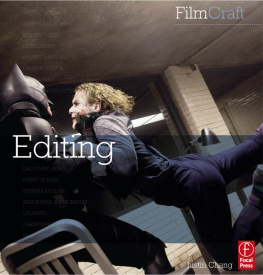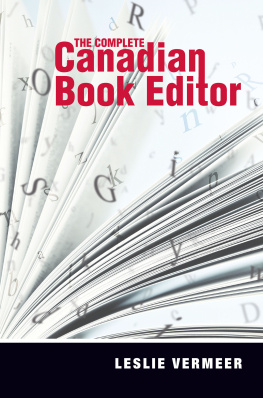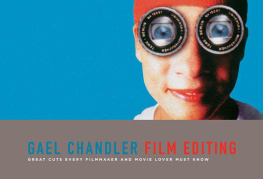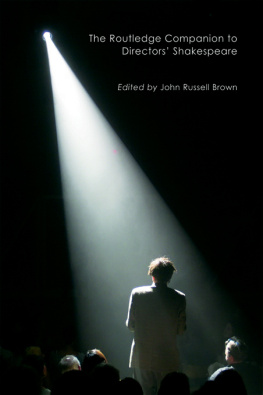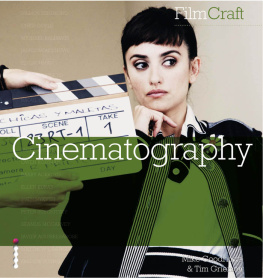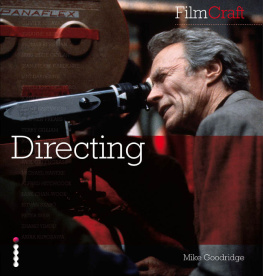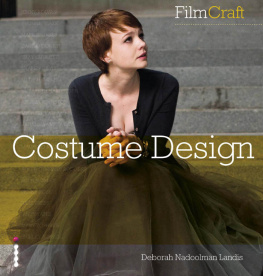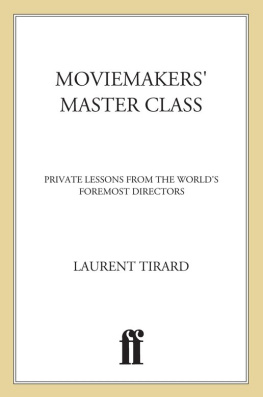
Film Craft

Editing
Justin Chang

Focal Press is an imprint of Elsevier Inc.
225 Wyman Street, Waltham
MA 02451, USA
Copyright 2012 The Ilex Press Ltd.
All rights reserved
This book was conceived, designed, and produced by Ilex Press Limited, 210 High Street, Lewes, BN7 2NS, UK
Publisher: Alastair Campbell
Creative Director: Peter Bridgewater
Associate Publisher: Adam Juniper
Managing Editors: Natalia Price-Cabrera and Zara Larcombe
Editor: Tara Gallagher
Art Director: James Hollywell
In-house designer: Kate Haynes
Design: Grade Design
Picture Manager: Katie Greenwood
Digital Assistant: Emily Owen
No part of this publication may be reproduced, stored in a retrieval system or transmitted in any form or by any means electronic, mechanical, photocopying, recording or otherwise without the prior written permission of the publisher.
Permissions may be sought directly from Elseviers Science & Technology Rights Department in Oxford, UK: Phone (+44) (0) 1865 843830; Fax (+44) (0) 1865 853333; Email: . Alternatively visit the Science and Technology Books website at www.elsevierdirect.com/rights for further information
Notice: No responsibility is assumed by the publisher for any injury and/or damage to persons or property as a matter of products liability, negligence or otherwise, or from any use or operation of any methods, products, instructions or ideas contained in the material herein.
Trademarks/Registered Trademarks:
Brand names mentioned in this book are protected by their respective trademarks and are acknowledged.
Library of Congress Control Number:
A catalog record for this book is available from the Library of Congress.
Special thanks to Caroline Bailey, Dave Kent, Darren Thomas, Phil Moad, and Cheryl Thomas at The Kobal Collection, for all of their effort and support.
Every effort has been made to acknowledge pictures. However, the publisher apologizes if there are any unintentional omissions.
Digital ISBN: 978-0-2408-1865-8
For information on all Focal Press publications visit our website at:
www.focalpress.com


Table of Contents
Introduction
It is a well-known axiom that editing is the only cinematic discipline that did not precede the cinema itself. For centuries, writers, directors, actors, dancers, composers and production designers had a natural outlet for their talents in the theater, while still photography existed long before the key innovation of movement that gave rise to cinema. Even then, the act of filming required merely a camera and an object of the cameras attention. But the act of filmmaking suddenly required an editor, a creative technician who could step in after the performance had been captured and complete the illusion by arranging it into a form worthy of projection.
Editing is not only unique to cinema but a uniquely difficult discipline to comprehend, let alone discussa state of affairs to which this book is intended as some small corrective. Yet even some of the film editors interviewed here have difficulty articulating the precise nature of their work and the strategies they apply in the cutting room. I cant explain how I do what I do, Michael Kahn admits, while Anne V. Coates offers, I just cut the way I feel. One has only to witness the famous match cut from Lawrence of Arabia (1962) or the D-Day sequence that opens Saving Private Ryan (1998), to single out but two examples from these remarkable careers, to know that on the level that matters most, they know exactly what theyre doing.
For more concrete language on the subject, both Kahn and Coates directed me to their colleague Walter Murch, who has done more than anyone else inside or outside his profession to illuminate the public understanding of his discipline. Murch has described film editing as synonymous with film constructionthe careful assembly of a motion picture, scene by scene, shot by shot, frame by frame. Yet in his book In the Blink of an Eye, he also addresses a seemingly contradictory idea, which is the old adage that film editing is just where you cut out the bad bits. And he concedes that this shopworn notion, annoyingly reductive though it may be, nonetheless holds a kernel of truth.
Editing, after all, is an art achieved largely by subtraction, by a negation of those elements that do not serve the final product. Assembly, one of the most frequently used terms in the editors lexicon, can only take place after a significant amount of disassembly. Whatever tools the editor may be using, it is his or her job to comb through the footage, isolate the desired elements, and arrange them into a coherent and entertaining shape. More often than not, that shape is determined as much by what is taken out as by what is left in.
In any given film, then, the actors may impress us with the intensity and focus of their performances, and the cinematography may dazzle us with its sweep and beauty, but it is the film editor who maximizes the impact of these elements, sometimes by limiting rather than extending their duration. It is the film editor who, by dropping a few frames, can make the crucial difference between a joke that kills and one that overstays its welcome. Everything you see in a film is there because the editor decided to show it to you, and you can be assured that there is plenty more that the editor opted to withhold.
Thus, even the finest editing job, however elegant or economical, may be impossible to fully appreciate unless the viewer has seen the raw materials and thus has some sense of what has been discarded in the first place. As you read this book, from time to time you may catch a glimpse of those unseen, unheard moments: the snippets of song that Virginia Katz had to leave on the cutting-room floor of Dreamgirls (2006), the hilarious Robin Williams scene that Lee Smith saw scrapped from Dead Poets Society (1989), the extended Mexican wedding sequence that Stephen Mirrione ended up trimming for Babel (2006), or the lengthy dialogue passages that Valds skarsdttir had to excise, to her anguish, from Julien Donkey-Boy (1999).
This book is not a technical treatise but a series of conversations (from which my own voice has been excised) with 17 of the worlds leading practitioners of film editing, sharing their personal and professional insights into the movies theyve cut, the directors theyve collaborated with and the ever-changing nature of their specific medium. While the bulk of the interviews were conducted with editors based in the US, they also include contributions from Asia and Europe, hopefully providing a counter-perspective on the dominant mode of editing practiced within the Hollywood studio system. And just as a film editor may construct a picture with an eye toward establishing echoes, parallels and contrapuntal rhythms between individual scenes, so these chapters were assembled with the hope of placing these contributors in conversation with one another, creating an implicit dialogue between their respective views and methodologies.
Next page
